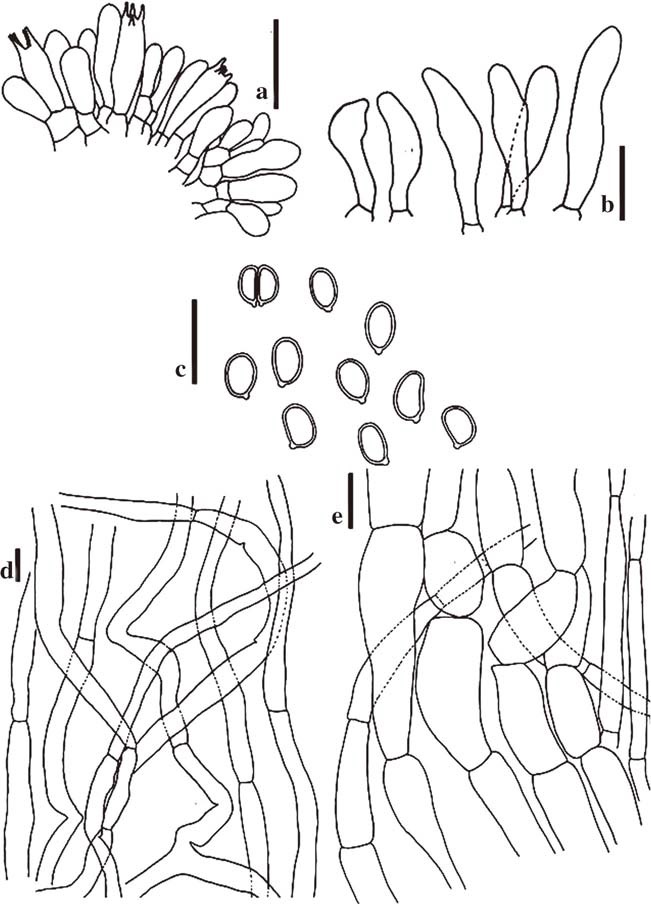Agaricus hanthanaensis Karunarathna& K.D. Hyde
Index Fungorum number: IF550892 Facesoffungi number: FoF00393
Etymology: refers to the type collecting site “Hanthana”.
Holotypus: MFLU11–0017 Pileus 190–200 mm diam., ovoid, plano-convex, applanate, at centre slightly depressed; surface squarrose or densly squamose, dark to light brown (6D5); squamules on the pileus reddish-dark brown (6D1), silky-fibrous, woolly, soft; colour readily changing to red on bruising, touching or cutting. Context in pileus 20–25 mm thick at the disc, fragile, white soon after cut, white to light yellow with age. Lamellae free, crowded with 8 tiers of lamellulae, 10 mm wide, ventricose, light brown (6D4) at first, then dark brown (6E4) to chocolate brown (6F8) at maturity, with concolourous even edge. Annulus,is not well visible but the remnants of the universal veil are visible on the stipe which forms the annulus, brown, floccose. Stipe 95×30 mm, at base 35 mm diam., cylindrical and subbulbous at base, without rhizomorphs, buried, solid; surface scabrous, reddish dark brown (6D1). Immediate discolouration on touching and cutting, context at top of stipe pale red, at bottom of the stipe pale yellow. Odour strong and peculiar. Basidiospores 4.2–6.5×2–3.5μm (x=5.1×2.8μm, Q=1.6– 2.2, Qm =1.7, n=40), ellipsoid, without germ pore, smooth, reddish-brown in mass, thick-walled. Basidia 20–27×6–8 (–9) μm, clavate, 4-spored. Cheilocystidia 30–50 (–56)×5–11μm, clavate, single, hyaline, smooth. Pleurocystidia absent. Pileipellis a cutis; hyphae 7–24μm diam., inflated, hyaline or light brown, with intracellular light brown pigments in dots. Stipitipellis hyphae similar to pileipellis hyphae 12–20μm diam. Clamp connections absent.
Macrochemical reaction: 5 % KOH reaction on pileus surface and stipe surface yellow (positive). Schaeffer reaction on dried tissue of the flesh of the cap and stipe base positive.
Habitat: solitary in humus-rich soil under heavily rotted litter in a highland forest. Fruiting during the middle of the rainy season, found under Dipterocarpus spp. and Pinus spp.
Material examined: SRI LANKA, Central Province, Kandy District, Hanthana Mountain Range, Peradeniya, rainforest with Dipterocarpus spp. and Pinus spp., 7°15′35.03″N 80°36′ 4.07″E, elev. 590 m, 5 July 2009, S.C. Karunarathna (MFLU11–0017, holotype). GenBank ITS: JQ246405.
Notes: The morphological characters (yellow KOH reaction, positive Schaeffer’s reaction, peculiar odour, well-developed pileus squamules, and clavate cheilocystidia) support the molecular data in that the species belongs to the section Spissicaules (Nauta et al. 1999). The basal part of the stipe context stains pale yellow, whereas the upper part stains pale red on cutting or bruising which are also characteristic features of the section Spissicaules (Nauta et al. 1999) where we place A. hanthanaensis. The dark brown pileus squamules on a dark to light brown background, the very thick fleshy (20–25 mm) large pileus (190–200 mm) and the universal veil remnants which forms the ring on the stipe of A. hanthanaensis easily distinguishes it from the other species of section Spissicaules. Agaricus hanthanaensis is remarkable amongst tropical Agaricus species because of its relatively large-sized solitary basidiocarps, as most tropical species of Agaricus have solitary, but small-sized basidiocarps (Zhao et al. 2011b). The surface of the basidiome changes from brownish to red on bruising or cutting. This new species bears superficial resemblance to A. bresadolanus but the latter species is distinct in having 36–85 mm pilei with 5.5–7.5×4–5μm, ellipsoid basidiospores and 13–25×7–11μm, clavate cheilocystidia (Nauta et al. 1999). In some aspects Agaricus hanthanaensis is similar to Agaricus simulans Berk. which was first described from Sri Lanka as a fleshy species typical of the subgenus Lanagaricus with a large basidiome (~140 mm), but it differs in having ovoid spores, a floccose annulus formed by universal veil, sticky scales on the pileus and stipe and smaller cheilocystidia (28–32×6.5–7.5μm) (Pegler 1986). Our new species also shares some similarities with A. parasilvaticus Heinem., but the latter is distinct in having a 6 mm thick context, 25–60 mm wide pilei, a superior annulus and 13– 37.5×7–15μm cheilocystidia (Heinemann 1962a).

Agaricus hanthanaensis (MFLU 11–0017, holotype) a–b.Basidiome in the field. c–d Basidiome in the laboratory

Agaricus hanthanaensis (MFLU 11-0017, holotype) a Basidia. b Cheilocystidia. c Basidiospores. d Hyphae on Stipipellis. e Hyphae on Pileipellis. Scale bars: a, b, d, e=20μm, c=10μm
Read more: http://link.springer.com/article/10.1007/s13225-015-0324-y

